
In the United Kingdom, raptor persecution is a crime against wildlife. The offence includes poisoning, shooting, trapping, and nest destruction or disturbance of birds of prey. [1]

In the United Kingdom, raptor persecution is a crime against wildlife. The offence includes poisoning, shooting, trapping, and nest destruction or disturbance of birds of prey. [1]
There is a long history of game bird shooting and hunting for sport, and the international trafficking of wildlife products, including raptors and raptor feathers, is a billion-dollar industry. [2] Understanding and suppressing raptor persecution is complex, because the reasons behind it are shaped by local, cultural and historic conditions. [2]
In some countries raptors are hunted for use in falconry. In China, people capture eagles and other raptors for falconry festivals that attract tourists. [2] In Germany, buzzards and hawks are at risk, and the red kite is endangered. [3] In the European Union, the EU Birds Directive (Council Directive 79/409/EEC 1979) regulates the hunting of all wild birds, stating that they must not be caught, killed or persecuted (with the exception of proper hunting). [4] Campaigning groups in Germany have identified hunting and poaching hotspots on migratory routes across the continent. [5] Persecution increased across Europe during the COVID-19 Pandemic. [6]

Birds of prey are protected species in the United Kingdom, and criminal offences against them are covered by the Wildlife and Countryside Act 1981. But it is a crime that is difficult to monitor, due to the remoteness of many of the areas in which the birds live and cultural and social pressures in certain sectors of the rural community which discourage reporting. [7] Incidents of egg thefts and illegal killings of birds of prey, including red kites, peregrine falcons and barn owls, increased in England during the lockdown periods of the COVID-19 pandemic as the absence of the public emboldened gamekeepers and miscreants. [8] [9] [10] In Wales, however, the number of offences has decreased, as egg thefts have fallen dramatically there. [11]
The Royal Society for the Protection of Birds (RSPB) began recording raptor persecution in 1990. Their Birdcrime report covers known offences against birds of prey. The report describes this crime as widespread and relentless, [12] but results in very few convictions. [13] In 2020 the RSPB confirmed 137 incidents. [9] Many of the confirmed incidents occurred on land managed for gamebird shooting.
The Scottish Raptor Monitoring Scheme works to improve co-operation between organisations involved in raptor monitoring in Scotland. [14] Founded in 1980, The Scottish Raptor Study Group monitor and record the fortunes of raptor species across Scotland. Since 2002 they have produced an annual report. In the Scottish Raptor Monitor Scheme common ravens are included as honorary raptors because they are ecologically similar. [14]

Golden eagles are being reintroduced in southern Scotland. [15]
North Yorkshire has particularly high raptor persecution levels. [16] The survival of the hen harrier in the UK is of particular concern as one of Britain's most endangered birds because of illegal persecution. [17] [18] Hen harriers share space with grouse, and research shows that hen harriers fare best on those estates with no shooting interests. [19] The interests of conservationists often clash with gamekeepers and landowners. [20] [21]
The Welsh Government began funding an RSPB Raptor Officer in 2020. [19] [22]
The Police Service of Northern Ireland investigate incidents in relation to the Wildlife (Northern Ireland) Order 1985 and the Wildlife & Natural Environment Act (Northern Ireland) 2011. [23] No-one has ever been successfully prosecuted for raptor persecution offences in Northern Ireland. [19]
In 2020 the British Association for Shooting and Conservation and other country sports groups including the Countryside Alliance, the Moorland Association, the National Gamekeepers' Organisation declared "zero tolerance" against raptor persecution. [24]
In June 2023 the Guardian newspaper published details of raptor persecution allegations pertaining to the Royal estate at Sandringham. [25]
In January 2024 Scottish news highlighted cases of peregrine laundering from Scotland to the Middle East [26]
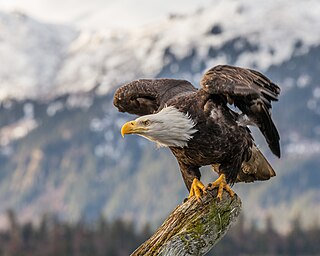
The bald eagle is a bird of prey found in North America. A sea eagle, it has two known subspecies and forms a species pair with the white-tailed eagle, which occupies the same niche as the bald eagle in the Palearctic. Its range includes most of Canada and Alaska, all of the contiguous United States, and northern Mexico. It is found near large bodies of open water with an abundant food supply and old-growth trees for nesting.

The peregrine falcon, also known simply as the peregrine, and historically as the duck hawk in North America, is a cosmopolitan bird of prey (raptor) in the family Falconidae. A large, crow-sized falcon, it has a blue-grey back, barred white underparts, and a black head. The peregrine is renowned for its speed. It can reach over 320 km/h (200 mph) during its characteristic hunting stoop, making it the fastest animal on the planet. According to a National Geographic TV program, the highest measured speed of a peregrine falcon is 389 km/h (242 mph). As is typical for bird-eating (avivore) raptors, peregrine falcons are sexually dimorphic, with females being considerably larger than males.

Falconry is the hunting of wild animals in their natural state and habitat by means of a trained bird of prey. Small animals are hunted; squirrels and rabbits often fall prey to these birds. Two traditional terms are used to describe a person involved in falconry: a "falconer" flies a falcon; an "austringer" keeps Goshawks and uses accipiters for hunting. In modern falconry, the red-tailed hawk, Harris's hawk, and the peregrine falcon are some of the more commonly used birds of prey. The practice of hunting with a conditioned falconry bird is also called "hawking" or "gamehawking", although the words hawking and hawker have become used so much to refer to petty traveling traders, that the terms "falconer" and "falconry" now apply to most use of trained birds of prey to catch game. However, many contemporary practitioners still use these words in their original meaning.

The hen harrier is a bird of prey. It breeds in Eurasia. The term "hen harrier" refers to its former habit of preying on free-ranging fowl.
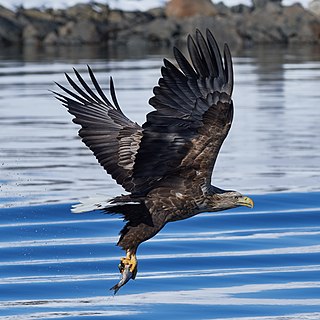
The white-tailed eagle, sometimes known as the 'sea eagle', is a large bird of prey, widely distributed across temperate Eurasia. Like all eagles, it is a member of the family Accipitridae which also includes other diurnal raptors such as hawks, kites, and harriers. One of up to eleven members in the genus Haliaeetus, which are commonly called sea eagles, it is also referred to as the white-tailed sea-eagle. Sometimes, it is known as the ern or erne, gray sea eagle and Eurasian sea eagle.

The northern harrier, also known as the marsh hawk or ring-tailed hawk, is a bird of prey. It breeds throughout the northern parts of the northern hemisphere in Canada and the northernmost USA.

The western marsh harrier is a large harrier, a bird of prey from temperate and subtropical western Eurasia and adjacent Africa. It is also known as the Eurasian marsh harrier. Formerly, a number of relatives were included in C. aeruginosus, which was then known as "marsh harrier". The related taxa are now generally considered to be separate species: the eastern marsh harrier, the Papuan harrier of eastern Asia and the Wallacea, the swamp harrier of Australasia and the Madagascar marsh harrier of the western Indian Ocean islands.
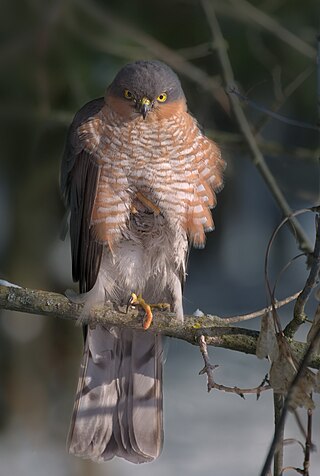
The Eurasian sparrowhawk, also known as the northern sparrowhawk or simply the sparrowhawk, is a small bird of prey in the family Accipitridae. Adult male Eurasian sparrowhawks have bluish grey upperparts and orange-barred underparts; females and juveniles are brown above with brown barring below. The female is up to 25% larger than the male – one of the greatest size differences between the sexes in any bird species. Though it is a predator which specialises in catching woodland birds, the Eurasian sparrowhawk can be found in any habitat and often hunts garden birds in towns and cities. Males tend to take smaller birds, including tits, finches and sparrows; females catch primarily thrushes and starlings but are capable of killing birds weighing 500 g (18 oz) or more.
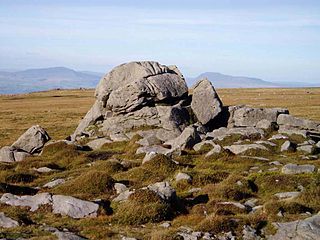
The Forest of Bowland, also known as the Bowland Fells and formerly the Chase of Bowland, is an area of gritstone fells, deep valleys and peat moorland, mostly in north-east Lancashire, England, with a small part in North Yorkshire. It is a western outlier of the Pennines.

The harpy eagle is a large neotropical species of eagle. It is also called the American harpy eagle to distinguish it from the Papuan eagle, which is sometimes known as the New Guinea harpy eagle or Papuan harpy eagle. It is the largest bird of prey throughout its range, and among the largest extant species of eagles in the world. It usually inhabits tropical lowland rainforests in the upper (emergent) canopy layer. Destruction of its natural habitat has caused it to vanish from many parts of its former range, and it is nearly extirpated from much of Central America. The genus Harpia, together with Harpyopsis, Macheiramphus and Morphnus, form the subfamily Harpiinae.

The prairie falcon is a medium-large sized falcon of western North America. It is about the size of a peregrine falcon or a crow, with an average length of 40 cm (16 in), wingspan of approximately 1 meter (40 in), and average weight of 720 g (1.6 lb). As in all falcons, females are noticeably bigger than males. Though a separate species from the peregrine, the prairie falcon is basically an arid environment divergence of the early peregrine falcon lineage, able to subsist on less food than the peregrine, and generally lighter in weight than a peregrine of similar wing span. Having evolved in a harsh desert environment with low prey density, the prairie falcon has developed into an aggressive and opportunistic hunter of a wide range of both mammal and bird prey. It will regularly take prey from the size of sparrows to approximately its own weight, and occasionally much larger. It is the only larger falcon native only to North America. It is resident from southern Canada, through western United States, and into northern Mexico. The prairie falcon is popular as a falconry bird, where with proper training it is regarded as being as effective as the more well known peregrine falcon.

In the United Kingdom, a gamekeeper is a person who manages an area of countryside to make sure that there is enough game for hunting, or fish for fishing, and acts as guide to those pursuing them.
The Peregrine Fund is a non-profit organization founded in 1970 that conserves threatened and endangered birds of prey worldwide. The successful recovery of the peregrine falcon in the United States, which was removed from the U.S. Endangered Species List in 1999, enabled the organization to expand its mission to include other endangered raptors around the world. The Peregrine Fund is headquartered at its World Center for Birds of Prey in Boise, Idaho, on a 580-acre (2.3 km2) campus with breeding and research facilities, an administrative office, interpretive center, research library, and archives.
Game preservation is maintaining a stock of game to be hunted legally. It includes:
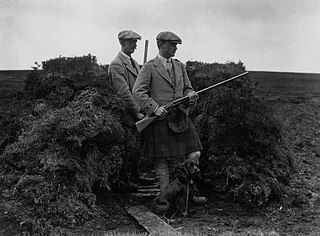
Driven grouse shooting is a field sport in the United Kingdom involving the shooting of red grouse. It is one of two forms of the sport, the other is walked-up shooting. Driven grouse shooting involves grouse being driven to fly over people with shotguns in fixed positions. In walked-up shooting the participants walk forward in a line and flush the birds as they go. Walked-up shooting is more physically demanding than a driven shoot and typically involves fewer birds being shot.

The golden eagle is one of the most powerful predators in the avian world. One author described it as "the pre-eminent diurnal predator of medium-sized birds and mammals in open country throughout the Northern Hemisphere". Golden eagles usually hunt during daylight hours, but were recorded hunting from one hour before sunrise to one hour after sunset during the breeding season in southwestern Idaho. The hunting success rate of golden eagles was calculated in Idaho, showing that, out of 115 hunting attempts, 20% were successful in procuring prey. A fully-grown golden eagle requires about 230 to 250 g of food per day. In the life of most eagles, there are cycles of feast and famine, and eagles have been known to go without food for up to a week. Following these periods without food, they will then gorge on up to 900 g (2.0 lb) at one sitting. The powerful talons of the golden eagle ensure that few preys can escape them once contact is made. The talons of this species exert approximately 440 pounds per square inch (3 MPa) of pressure, around 15 times more pressure than is exerted by the human hand, although some claim that the largest individual females may reach a pressure of 750 psi (5.2 MPa). It has been claimed that the golden eagle can lift more than its own body weight in flight. However, other sources claim that a hare, marmot or deer calf weighing 4 kg (8.8 lb) is a struggle for even a large female to carry and that prey much over 2 kg (4.4 lb) would require favorably high wind conditions.

Roger Geoffrey Clarke, was an English ornithologist and world authority on harriers and other birds of prey.

At one time, the golden eagle lived in a great majority of temperate Europe, North Asia, North America, North Africa, and Japan. Although widespread and quite secure in some areas, in many parts of the range golden eagles have experienced sharp population declines and have even been extirpated from some areas. The total number of individual golden eagles from around the range is estimated to range somewhere between 170,000 and 250,000 while the estimated total number of breeding pairs ranges from 60,000 to 100,000. Few other eagle species are as numerous, though some species like tawny eagle, wedge-tailed eagle and bald eagle have total estimated populations of a similar size to the golden eagle's despite having distributions which are more restricted. The world's most populous eagle may be the African fish eagle, which has a stable total population estimated at 300,000 individuals and is found solely in Africa. On a global scale, the golden eagle is not considered threatened by the IUCN.

Hawkwatching is a mainly citizen science activity where experienced volunteers count migratory raptors in an effort to survey migratory numbers. Groups of hawkwatchers often congregate along well-known migratory routes such as mountain ridges, coastlines and land bridges, where raptors ride on updrafts created by the topography. Hawkwatches are often formally or informally organized by non-profit organizations such as an Audubon chapter, state park, wildlife refuge or other important birding area. Some hawkwatches remain independent of any organizing structure.
The year 2017 in birding and ornithology.
{{cite web}}: |first= has generic name (help)